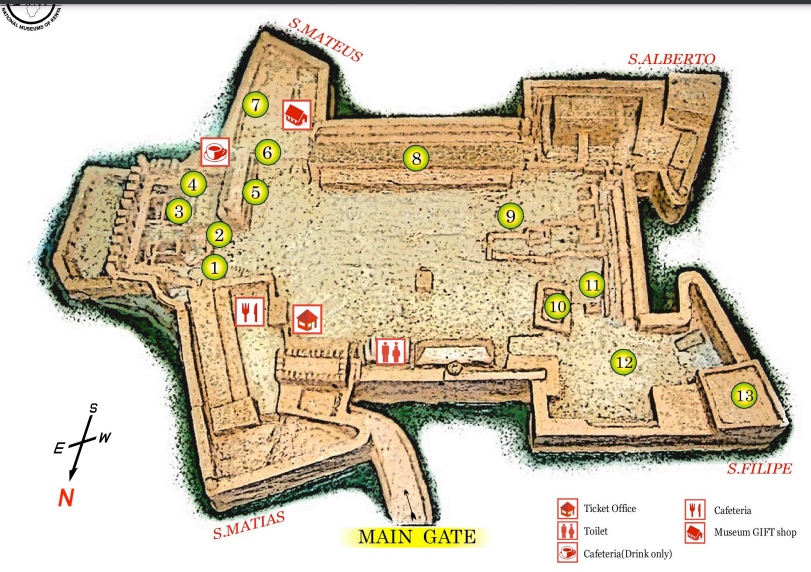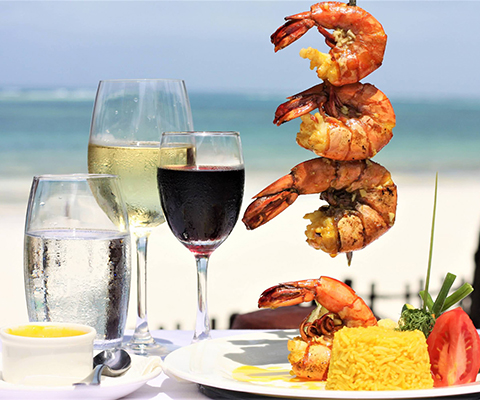Fort Jesus National Monument is situated in Mombasa Old Town, and can be accessed via Nkrumah Road. The historic Fort Jesus dates back to the end of the 16th Century; when it was used as a hiding place, a watch tower, a storage area, and a dwelling place.
Also Read: Reasons to visit Mombasa
The Fort Jesus was built in the form of a large human structure lying on the ground. It was made so to represent the position of Jesus Christ on the cross, as the Portuguese were Christian, hence the name Fort Jesus.
There’s a lot to see in at Fort Jesus, including:
- Captain’s house
- Passage of the arches
- Ammunition store
- Passage of the steps
- Portico Later Audience Hall
- Portuguese wall paintings
- Gun platform
- Museum gallery
- Church
- Cistern
- Well
- Skeleton
- Arab House Cavalier

This article will take a deep dive into all these parts of the Fort Jesus. But before we do that, here is a quick look at what the historic site is all about.
An Overview of Fort Jesus National Museum
The Historic Fort Jesus is one of the most outstanding examples of 16th-century Portuguese military fortification. Located in Mombasa, Kenya on the Indian Ocean coast, this UNESCO World Heritage Site stands as a testament to the cultural exchange between Africa and Europe during the Age of Exploration.
The fort has been subject to numerous renovations over its 400-year history, but many of its original features remain intact and have been preserved for the enjoyment of visitors. The interior of Fort Jesus is a maze of arched hallways, secret passageways, and courtyards that are filled with artifacts from its long history. Visitors can take in views of the city and seaside from the top of its imposing walls, wander through the prison cells, or explore its underground tunnels.
Fort Jesus provides an unforgettable experience of Mombasa’s past and is a must-see for anyone interested in Kenyan history. The fort also serves as an exciting cultural center, hosting year-round events such as musical performances, theatrical productions, and lectures by local scholars. The onsite museum houses an impressive collection of artifacts from the fort’s history, as well as rotating special exhibits.
With its fascinating history and unique atmosphere, Fort Jesus is a popular destination for both tourists and locals alike. Visitors can tour Fort Jesus on their own or with a guide. Guided tours are available in English, Spanish, French, and Swahili, making the fort accessible to all.
Fort Jesus Opening Hours
The historic museum is open from 8am in the morning to 6pm in the evening everyday.
Fort Jesus Admission Fee/Charges
Residents
Adults: KSH 200
Children (5-12): KSH 100
Non-Residents
Adults: USD 10
Children: USD 6
The fort also offers a range of activities such as guided tours, photography, and educational workshops. Visitors can also explore the grounds of Fort Jesus on their own to truly appreciate its beauty and history.
Brief History
Fort Jesus was declared a national park on 24th October 1958, and was officially opened to the public on 29th November 1960. Nine years later, on 1st January 1969, it was put under the national museums of Kenya.
Also read: What to pack when traveling to Mombasa
The historic site has a rich and fiery history of the Portuguese, British, and Arabs. There are interesting facts and theories about the fort, like the building of the fort by the Portuguese, and the fiery war between the three protagonists, the Portuguese, some locals, and Arabs.
The Portuguese built the fort mainly as a form of territory marking; they meant to secure a position on the Kenyan coast.
A Quick Preview of the Fort Jesus
As you enter the monument, you will see numerous canons around the compound, with some at the top of the walls and others pointing toward the entrance. The canons were used as weapons, in case of an attack. Those near the watch towers were long-range canons to fire towards enemies advancing from the ocean. Each group had distinctive canons; some had emblems and dates embedded in their canons.
The museum has several artefacts, models, and drawings. Among other things, you’ll learn about an exciting model of a ship that got wrecked in 1697 near the fort, the history its tours, her services and trips before her wrecking and sinking. You’ll also see the Swahili display, featuring Persian and Portuguese utensils, porcelain, etc. and ornaments from the Bajuni, a tribe in the coastal region.
You’ll also get a glimpse of the bones of a juvenile male humpback whale. This whale was washed by waves to the shores of Ungwana bay- Tana River County where locals found it around June 1992.
A Complete Breakdown of All Sections in the Fort Jesus
Here is a breakdown of all the section in the Fort Jesus Museum, as elaborated by the National Museums of Kenya.
Captain’s House
The Captain’s house was carried over the Passage of the Arches and extended to the outer wall of the platform, overlooking the outwork. The east wall was destroyed in the great siege and most of the south wall during the bombardment of1875.
Passage of the Arches
The Passage of the Arches was cut through the coral to merge in the outwork. After blocking of the gate, drainage from the court filled the passage with mud, which by early 19th century had reached the base of the relieving arch.
Ammunition Store
The passage is spanned by three arches which carried floors on the outer and inner segments. Leading off the passage is the Ammunition Store, comprising of two chambers excavated in the coral.
Passage of the Steps
These steps led down to a gate in the wall which emerged on the rock above the outwork. The windows at the south-end of the Audience Room is in the blocked entrance to this passage.
Portico Later Audience Hall
During the Mazurui period, the Portico was converted into an audience room. High up on the wall on the right-hand side of the door-way is a graffiti recording the pilgrimage of Mecca of the Mazurui Governor, Ahmad bin Muhammad, and his return in 1793.
Portuguese Wall Paintings
These pictures were painted in carbon black on the plaster of the revetment wall in the bastions of San Mateus, which was on the rear side of this room. The paintings were romed from the wall and restored.
Gun Platform
This was the most exposed part of the Fort and was strengthened by a broad platform extending round the west side and apex facing the sea.
Museum Gallery
The collection consists largely of ceramics, Chinese porcelain, Persian and Portuguese glazed ware and local and foreign earthenware, excavated at Swahili sites on the coast or acquired in Mombasa. It reflects the cosmopolitan culture which has been enjoyed by the coast for a thousand years.
Church
The entrance was at the east end, and the room on the left of the altar was possibly a baptistery. The four platforms in the nave may be the bases of the walls which supported beams carrying a series of lights or openings below a long gable roof. The Portuguese used the chapel for religious purposes.
Cistern
The cistern was built about1603 by the Portuguese. Rainwater was collected from the roof off the nearby church and from other buildings and was led into the cistern through covered drains.
Well
The well was built by the Omani Arabs soon after they captured Fort Jesus in 1698. It is 23 meters (76ft) deep and has salty water that’s only fit for washing.
Skeleton
The human skeleton in Fort Jesus was found in-situ. The see-through coffin carries the replica of the bones of a human that was found buried at that very spot. The original bones are said to be under the replica.
Arab House Cavalier
This house was built in the late 18th century, but was remodeled during the prison times when it served as the Chief Warder’s house. The top of this house gives a good view of the Mombasa old town.
Museum Gift Shop
Lying behind of the museum Gallery is the gift shop that carries a host of souvenirs. Here, you can shop for antique items that will cement your memories of Mombasa.
Cafeteria
Finally, you can grab some cold drinks and try out different Swahili cuisines at the cafeteria.










